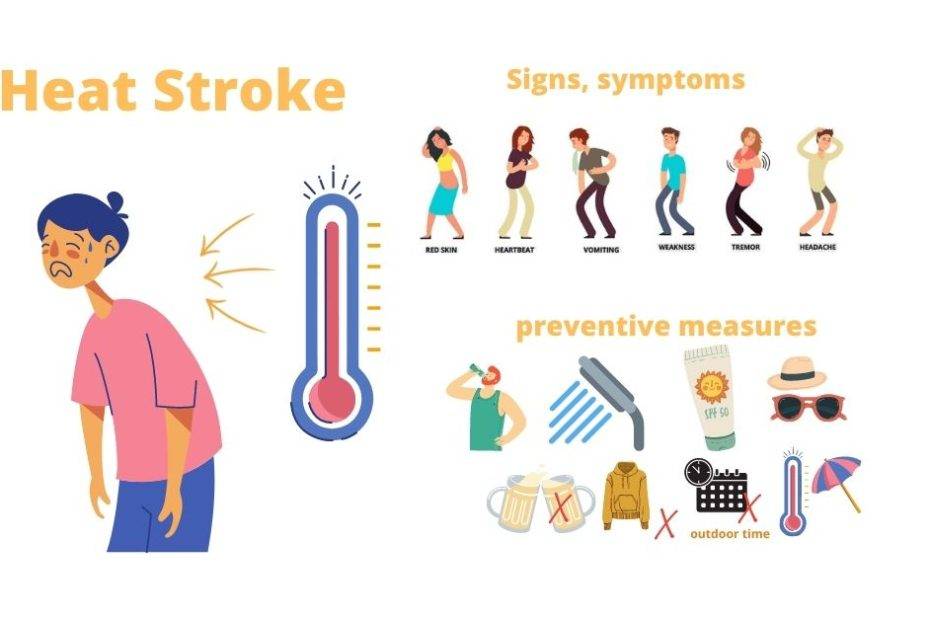What is Heatstroke?
Heatstroke and heat injury are defined as a core body temperature elevated above 100 degrees Fahrenheit associated with central nervous system dysfunction and end-organ damage.
The CNS dysfunction can be observed in several ways including confusion, delirium, aggression or seizures, altered consciousness, and coma. Classical heat exhaustion generally happens in the elderly population in the summer season which can be related to a lack of access to air conditioning. Heatstroke is seen in younger and more athletic populations due to hot and humid environments.
what is Heat exhaustion?
Heat exhaustion is the body's response to an excessive loss of water and salt, usually through excessive sweating. Workers most prone to heat exhaustion are those that are elderly, have high blood pressure, and those working in a hot environment.
Difference between Heatstroke and Heat exhaustion
| Heatstroke | Heat exhaustion |
Symptoms:
What to do?
|
Symptoms:
What to do?
|
Signs and symptoms of heatstroke
The signs may include
- Headache
- Dizziness and confusion
- Loss of appetite and feeling sick
- Excessive sweating and pale clammy skin
- Cramps in arms legs and stomach
- Fast breathing or rapid pulse
- High body temperature of 104 degrees Fahrenheit or above
- Being very thirsty
Preventing heat exhaustion and heat stroke and
There is a high risk of heat exhaustion/ heat stroke during hot weather outdoor play in the case of younger kids. Patients with heat stroke should undergo rapid cooling
- Remove the patient's lock and place the patient in a cool well ventilated room
- If the patient is the unconscious, position him on his or her side and clear their way
- Monitor body temperature every 5 minutes, measurement of the patient's core temperature of the rectal probe is recommended. The goal is to reduce the body temperature to 102 degrees Fahrenheit in 30 to 60 minutes
- The patient body is exposed and used to enhance airflow over the body (Rapid evaporation method)
- The use of ice packs on the neck and groin is controversial because it increases peripheral vasoconstriction induced shivering
- Cold sponging with ice water can reduce the body temperature to some extent
- Antipyretics are ineffective because the hypothalamic set point during heat stroke is normal despite the increase in body temperature.
How to do lower body heat quickly?
The following home remedies are easy and effective ways to beat the heat
- Cold footbath: – placing the feet in a cold footbath cools the body and allows one to sit back and relax. Add a few drops of peppermint essential oil for adding a cooling effect
- Coconut water – It is a great way to refresh and revitalize the body the vitamins minerals and electrolytes in coconut water make it an effective way to rehydrate and energize the body when the kids have heat stress
- Hydrating foods – Make them eat plenty of foods high in water content. Fruits such as cantaloupe, watermelon, and strawberries are good options. Try to include lots of vegetables such as cucumber, bottle gourd, and broccoli in the diet. If they are showing no interest in solid foods, make healthy smoothies with fruits and yogurt as yogurt has a cooling effect.
- Dress accordingly -Make them wear loose light-colored clothing with natural fabric such as cotton to combat body heat.
- Sunscreen- Play it cool. Use sunscreen with an SPF of more than 35 while going out to reduce the amount of harmful UVA &UVB Avoid sun rays from11:00 a.m. to 5 pm
- Aloe Vera -The leaves and the inner gel of this plant can help to lower the body temperature applied to the skin
- Buttermilk – Drinking buttermilk to cool down the body and improve metabolism. It is full of probiotics, vitamins, and minerals that will help to restore the body's natural energy if they are feeling drained by the heat
- Fenugreek -Fenugreek seeds have a cooling effect as they help to bring down the sweat-soaked fenugreek seeds in plain water overnight and let them drink early in the morning to cool down the body

Thanks for your blog, nice to read. Do not stop.
Thank you for your comment 🙂